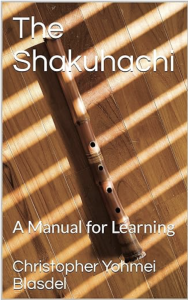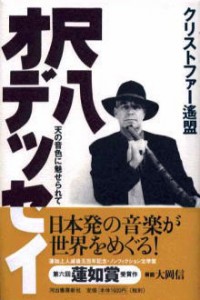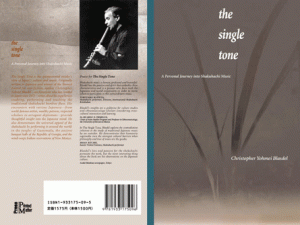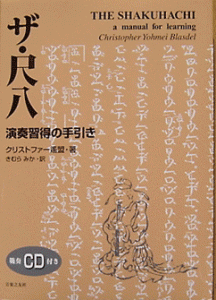For information on purchase of these books, please go the the shop page.
English:
The Single Tone—A Personal Journey into Shakuhachi Music
(C) Copyright 2005 Christopher Yohmei Blasdel. All Rights Reserved.
The English version of Blasdel’s award winning essay on learning shakuhachi in Japan (Shakuhachi Odyssey–see below) has been re-written for English language readers and is now available as an E-book on Apple Books or for Kindle on Amazon.
Originally published in 2005 as a paperback, The Single Tone—A Personal Journey into Shakuhachi Music is a highly perceptive and objective view of Japan’s culture and music written by a long-term American expat who lived most of his life in Japan. Christopher Yohmei Blasdel resided over 45 years in Tokyo and writes of his experiences studying, performing and teaching the traditional shakuhachi bamboo flute in Japan and around the world. He discusses the various legends surrounding the shakuhachi, its association with Zen Buddhism and the shakuhachi’s place in the Japanese culture. He also relates his personal encounters with various people, from renown artists, wealthy patrons, respected scholars to arrogant Japanese diplomats. His writings provide thoughtful insight into the Japanese mind and, through his world travels and performances in such diverse venues as the jungles of Guatemala, the ancient halls of the Republic of Georgia, and wind-swept Native American reservations in New Mexico, demonstrates the universal appeal of the shakuhachi. The E-Book edition has been updated with new photos.
Praise for The Single Tone:
“Shakuhachi music is honest, profound and beautiful. Blasdel has the passion and spirit that embodies these characteristics and is a pioneer who faces both the Japanese and world communities in order to invite others to participate in this extraordinary music. (Yokoyama Katsuya: shakuhachi performer, 1934-2010)
“Blasdel’s insights are a goldmine for culture studies and ethnomusicology scholars considering cross-cultural interactions and learning.” (Dr. Ricardo Trimillos: Professor Emeritus, University of Hawai’i)
“In The Single Tone, Blasdel explores the contradictions inherent in the study of traditional Japanese music by an outsider. He demonstrates that humanity supersedes even the strongest cultural barriers when philosophy and love of music are the guides.” (Brian Ritchie: Violent Femmes bassist, shakuhachi performer)
Blasdel’s love and passion for the shakuhachi permeates the work, but the most interesting aspects about this book are the observations on the Japanese culture. (Asahi Shinbun newspaper)
The Shakuhachi, A Manual for Learning
 (C) Copyright 2024 Christopher Yohmei Blasdel.
(C) Copyright 2024 Christopher Yohmei Blasdel.
All Rights Reserved.
The e-book version of The Shakuhachi, A Manual for Learning, one of the first comprehensive English-language shakuhachi instruction books, is now available on Amazon Kindle at the significantly reduced price of $9.99. Originally published in 1986 by Ongaku no Tomo-sha, Japan’s leading music press, The Shakuhachi has undergone numerous editions and helped many beginner and intermediate players learn more about the instrument and how to play it. This book covers all the basic aspects of learning the shakuhachi, beginning with a chapter on bamboo and shakuhachi making, how to handle the instrument, tone production, as well as basic fingering and Kinko style ornamentation techniques. Also included in the book are a series of graduated shakuhachi practice exercises, from simple tunes to some of the lofty classical sankyoku pieces. These exercises, along with recorded examples, are also available for free download.
You can view the Amazon site here.
Shakuhachi Odessei
 Copyright 2001 Christopher Yohmei Blasdel.
Copyright 2001 Christopher Yohmei Blasdel.
All Rights Reserved.
This book, which was awarded the 6th Rennyo Award for non-fiction writing in Japan, describes the author’s arrival in Japan, the meeting and long years of tutelage under shakuhachi master Goro Yamaguchi and encounters with artists like the sculptor Isamu Noguchi and ethnomusicologist Fumio Koizumi. A chapter on the history of the shakuhachi sheds light on some of the myths concerning the instrument and the meaning they hold for the present day. There is also much written about the present day system of music education in Japan and the author’s peregrinations about the world performing shakuhachi and Japanese music. The English version is called “The Single Tone, A Personal Journey into Shakuhachi Music.
Sold Out
Za Shakuhachi, Ensou Shutoku no Tebiki
(C) Copyright 2001 Christopher Yohmei Blasdel. All Rights Reserved.
Japanese translation of “The Shakuhachi, A Manual for Learning.”
Japanese edition.


